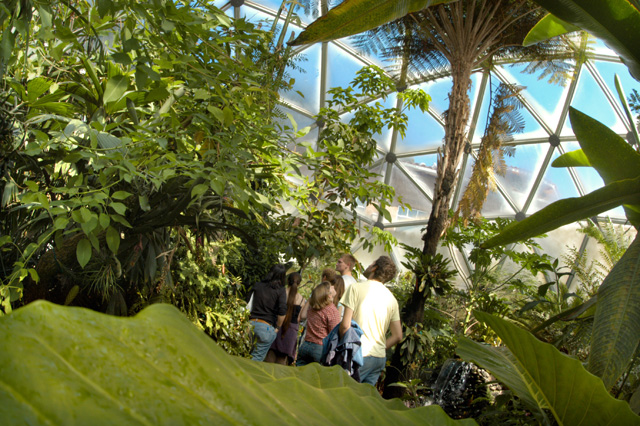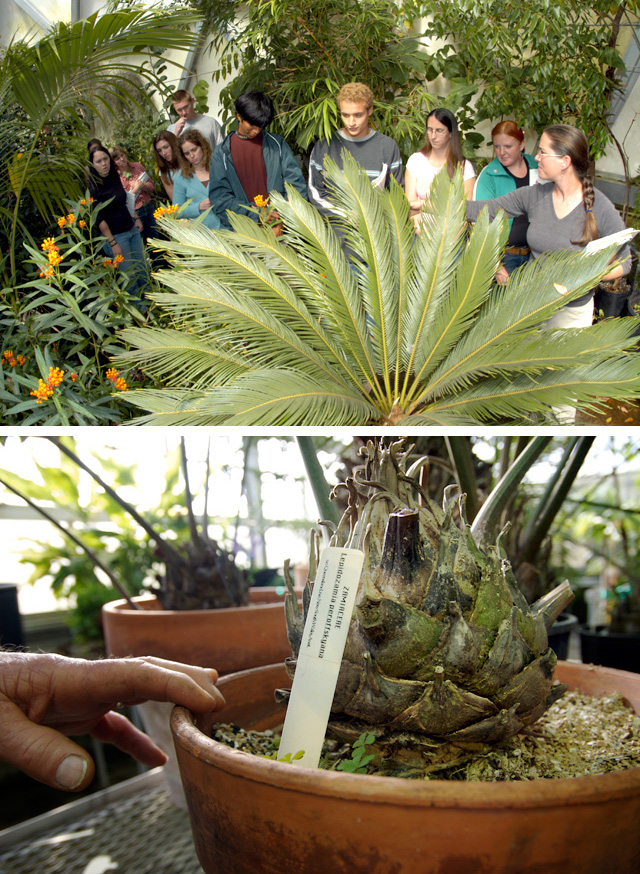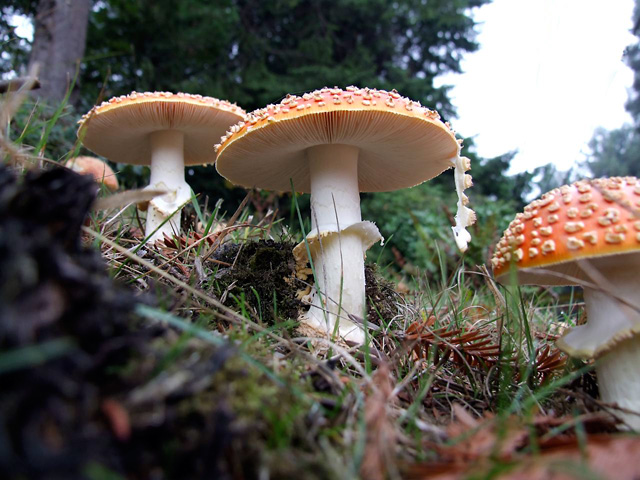
… he developed his very own classification system—he’s got to be in the running.
Never heard of any of these people? Don’t worry, you’re not alone. While we live enveloped by a sea of plants, grasses, algae and fungi, modern society’s knowledge of the natural world, and hence the field of botany, is pretty limited. But, at Humboldt State, a core of dedicated professors and students are ensuring the world is kept in steady supply of well-educated, highly trained botanists.
Largest Undergraduate Botany Program in the Nation
Humboldt State’s Botany program is home to an expansive 11,500 square foot collection greenhouse containing approximately 1,800 plant specimens, a 2,500 square foot research greenhouse and the largest vascular plant herbarium in the California State University system with nearly 100,000 specimens. It’s these unique teaching and research facilities, coupled with dedicated professors who are experts in their fields, which have allowed Humboldt State to become the largest undergraduate Botany program in the United States. With 91 students choosing the major, HSU’s program is home to more future botanists than any other campus including the University of California, Berkeley, the country’s next largest program, with 60 plus students.
“We have a very broad selection of botanical courses from which a student may choose from; our breadth is exceptional,” says Professor Casey Lu, chair of the Department of Biological Sciences, which houses the Botany major. “We also have a really strong and in-depth lab component in the majority of our courses and that’s something we’ve tried to retain.”

The program’s ambitious scope and well-deserved reputation was built over decades by professors passionate about and committed to studying plants. Lu credits HSU botany professors such as David Largent, Robert Rasmussen, John Sawyer, James Smith, Dennis Walker and others who came before Lu arrived, for establishing the nation’s premier undergraduate botany program.
“Botany has been a strength at HSU for a long time. Our strength came from the previous cohort of professors,” Lu says. “We’re just trying to carry on that tradition.”
Removing the Green Blurs
“Usually, when students arrive at our program they sort of know about plant life, but not too much,” says Professor Frank Shaughnessy, a marine algae and seagrass specialist. “Then you get a professor explaining how these organisms work and how they’re put together. We call it removing the green blurs—the students’ understanding of botanical life starts off blurry and then we just keep adding layer upon layer of knowledge and it gets sharper and sharper.”
Shaughnessy explains that the entry-level botany courses help students build a strong science foundation, gaining an in-depth understanding of the various organisms they will study during their academic careers. Hands-on learning, both in the lab and in the field, is a major component of the program and yet another reason it has been so successful.
“With our greenhouse, forest walks, trips to coastal intertidal areas, alpine zones—I’d say we have more field time than other botany programs simply because we can,” Shaughnessy says. “We have a spectacular natural setting and it would be ridiculous to not take advantage of it and that’s one of the things that makes us unique. Other programs can’t do that as inexpensively as we can.”
Once students are enrolled in the Botany program, the University’s facilities, its natural setting and an abundance of research opportunities keep them busy and interested. But, why do students choose to come to HSU to study botany in the first place?
“The students are interested in life, protecting it and working on environmental problems,” Shaughnessy says. “The desire to save the world is definitely something that our students bring here to HSU—they’re defining us in that way. That’s what attracts them to Humboldt.”
The North Coast: A Mycologist’s Paradise
It’s hard to imagine a better place to study mycology than Humboldt State. With a distinctive coastal climate that provides ample opportunities for fungi to proliferate, students are able to get unparalleled hands-on experiences in the field, often just minutes from campus. Largent, who developed the mycology specialization at Humboldt State for decades up until his retirement in the 1990s, left in his wake a robust program that regularly produces some of the world’s top mycologists. For example, one of Largent’s former students, Professor Timothy Baroni of State University of New York, Cortland, recently discovered a new genus of polypore mushroom while on an expedition funded by the National Geographic Society in the remote mountains of Belize.
Upon Largent’s retirement, Professor Terry Henkel took the reins and now heads the mycology program. While completing his doctoral dissertation at Duke University in North Carolina, Henkel found out about the opening for a mycology professor at HSU and was immediately excited about the opportunity.
“If you’re into field-oriented biology, especially botany, and good training at the undergraduate level in a traditional broad sense, you know about this school,” Henkel says. “One of the reasons is that you run into people who are Humboldt graduates all over the place. They’re either working for federal agencies as staff botanists or you meet a number of people that went on to graduate schools who are now professors, and that’s especially true for mycology.”
Henkel sees his charge as carrying on the tradition started by Largent of educating highly skilled mycologists that go on to be leaders in their field. Aside from time spent in the classroom and lab, Henkel takes his students on numerous field trips every semester to identify and collect fungal specimens. One of his classes even takes its final exam in the field during an overnight camping trip at a local collecting spot near the Smith River. Henkel guides his students on a mushroom hunt during the first day of the excursion and has the collected specimens laid out at the group’s campsite the following morning complete with accompanying test questions.

“We’ve got the perfect collusion of ecosystems and climate,” Henkel says. “We can rely on fresh material for nearly everything. If we want to study specific fungal groups, at almost any given time of the academic year we can go out and collect representatives either as a class or myself with lab assistants. Very few other places in the entire country can boast that.”
Mycology students also have remarkable research opportunities with Henkel in Guyana where the professor travels annually to collect specimens. He began visiting the South American nation while working on his Ph.D. at Duke and has brought his students with him on expeditions every year since coming to HSU. The country, with its pristine natural setting, is rich in biodiversity and home to a vast collection of yet-to-be-identified fungi specimens. Several of Henkel’s students have crafted their senior or master’s thesis based on research conducted in Guyana.
“Usually what happens is that I have certain students in my courses that I get to know pretty well,” Henkel says. “The students know we have work going on in Guyana and they really want to go. They’re dying to get that field experience and they’ve heard me talking about it, so I’ve got them all jacked up with photos from airplanes of remote forests going on for miles and working with unusual fungi we found. It’s a pretty cool situation.”
Spreading the Botanical Word
While Humboldt State professors and students are passionate about botany, modern society doesn’t regard the study of plants as highly as it once did. Motivated by economic factors, if botanical researchers aren’t pioneering new medicines or foods, Lu says, outside interest is limited. However, Lu and Shaughnessy stress the continued need for professional botanical scientists in a variety of settings including working with government agencies or environmental services firms.
“Botany faculty have to have a missionary zeal because we know how important plant life is,” Shaughnessy says. “Thanks to the media and our popular culture we kind of have a sense of what messages have been out there and we know that it’s a really incomplete picture. We are very aware that’s our operating environment and thus we need to have a real passion for our discipline.”
So, even if you didn’t know that Fuchs, Brunfels and Bock are the three recognized fathers of modern botany, don’t feel too bad. In a world where plant life is often disregarded if it fails to generate economic returns, having basic knowledge about the ferns, algae and fungi that make up our natural environment is exceedingly more useful than remembering the names of three long-dead German scientists. With Humboldt State’s 91 eager students and its team of dedicated botany professors on the case, the discipline’s foundations will continue to be strong.